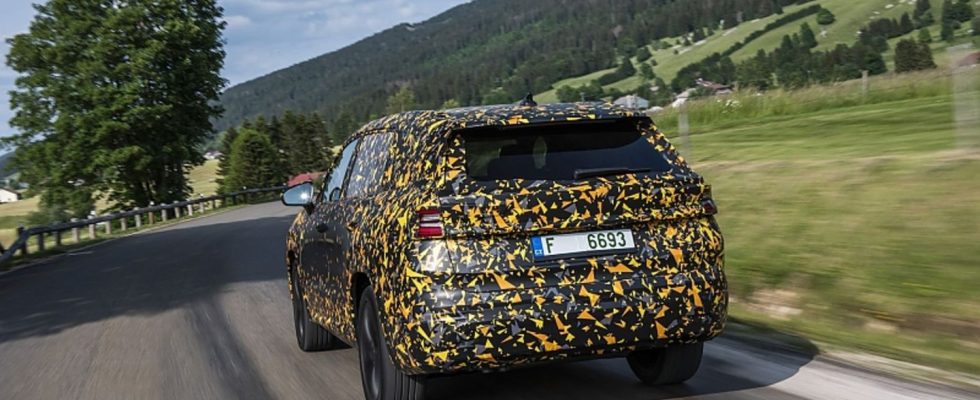Technology: The new Skoda Kodiaq can do that
It’s all in the mix
Skoda Kodiaq
© press-inform – the press office
The new Skoda Kodiaq should roll into the large tire tracks of its predecessor from the middle of next year. In order for this to succeed, the technicians have made improvements in many areas. The new one is larger than before, gets a PHEV drive with an electric range of 100 kilometers and an improved operating concept.
The curse of doing good deeds can create a dilemma for automakers. With its combination of practicality and space, the Skoda Kodiaq has been a top seller since it appeared in 2016: around 792,000 drivers have opted for the Czech SUV to date. In Germany there are around 114,000 – impressive numbers that fundamentally changed the image of the small budget brand Skoda. Around 50 percent of the cars sold are now crossovers. Now the second generation of the Kodiaq is in the starting blocks and the question that those responsible at the VW subsidiary are now asking is how a successful car can be improved.
A measure that always works with a Skoda is even more space. So the Kodiaq is growing and now surpasses its predecessor by six centimeters with a length of 4.76 meters. The additional sheet metal is of particular benefit to the passengers in the third row of the seven-seater, who now enjoy 92 centimeters of headroom, 1.5 centimeters more than before. The trunk volume is also increasing: in the seven-seater it is 340 to 845 liters, without the third row it is 910 liters (plus 75 liters). More than enough. With this space, it hardly matters that the wheelbase is only one millimeter longer. There was and is enough space in the rear of the Kodiaq.
The keywords in the interior are: more intuitive operation and sustainability. For the fabrics, Skoda relies on recycled PET bottles and even the famous ice scraper and the umbrella are made of sustainable materials. The automatic lever has migrated to the steering wheel column, which leaves more space in the center console. This is used with four cup holders and two inductive 15-watt charging cradle including active cooling of the smartphone. So it’s a good thing that Apple CarPlay and probably Android Auto can be activated wirelessly. At first glance, the infotainment with the 10.25-inch digital instrument screen, the head-up display and the central 12.9-inch touchscreen resembles those of other manufacturers. However, Skoda not only relies on touchscreen operation, but also installs classic controls. An innovation is one level down with the three rotary knobs. The middle one is an “intelligent” one, where you can select one of four freely assignable functions at the push of a button and then set it. You can choose from a total of six functions, including the magnification of the navigation map, the volume, the driving modes and climate control settings for the seats. When it comes to assistants, Skoda promises that the Kodiaq is up to date. Autonomous parking of the car monitored by cell phone is new.
We’re already driving. We were in the big diesel with 142 kW / 193 hp and all-wheel drive. “We have taken some measures to reduce noise,” explains Škoda Board Member for Development Johannes Neft. The acoustic glass, which was not previously available on the Kodiaq, does its job very well. Road noise and wind noise are hardly noticeable on the new Kodiaq below 100 km/h. Despite a reinforced bulkhead towards the engine compartment, the diesel still has its say. Speaking of the drive. The prototypes with the well-known 2.0 TDI engine are still starting to feel weak. The engineers would have to make improvements before the market launch in the middle of next year.
The chassis, on the other hand, already makes a mature impression. With the adaptive dampers, the rebound and compression stages can now also be controlled separately, which leads to noticeably finer and smoother cushioning, although we were only in comfort driving mode, so we weren’t able to test the other settings. The same applies to the progressive steering, which does its piloting work unobtrusively and thus well. Only the feedback about the road conditions could be a little more pronounced. In order to make the final verdict, you would have to activate the other driving modes. It is pleasant that the dampers now also contribute to roll stabilization, which improves comfort.
Something is happening with the choice of engines. The big news is the plug-in hybrid with 150 kW / 204 hp system output, a battery with a capacity of 25.7 kilowatt hours and thus a standard range of around 100 kilometers. The electrification doesn’t stop there: the 1.5 TSI combustion engine (from the new generation of the EA 211 evo2 aggregate family, including cylinder deactivation) is fitted with a mild hybrid module (Mhev). With the resulting 110 kW / 150 hp you’re on the road, but of course you don’t tear out any speed trees. Unlike the Superb, the Kodiaq only uses the seven-speed DQ381 dual-clutch transmission with a wet clutch. So the chances are good that the Kodiaq success story will continue.

